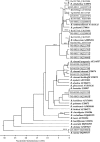Identification of Bartonella infections in febrile human patients from Thailand and their potential animal reservoirs
- PMID: 20519614
- PMCID: PMC2877425
- DOI: 10.4269/ajtmh.2010.09-0778
Identification of Bartonella infections in febrile human patients from Thailand and their potential animal reservoirs
Abstract
To determine the role of Bartonella species as causes of acute febrile illness in humans from Thailand, we used a novel strategy of co-cultivation of blood with eukaryotic cells and subsequent phylogenetic analysis of Bartonella-specific DNA products. Bartonella species were identified in 14 blood clots from febrile patients. Sequence analysis showed that more than one-half of the genotypes identified in human patients were similar or identical to homologous sequences identified in rodents from Asia and were closely related to B. elizabethae, B. rattimassiliensis, and B. tribocorum. The remaining genotypes belonged to B. henselae, B. vinsonii, and B. tamiae. Among the positive febrile patients, animal exposure was common: 36% reported owning either dogs or cats and 71% reported rat exposure during the 2 weeks before illness onset. The findings suggest that rodents are likely reservoirs for a substantial portion of cases of human Bartonella infections in Thailand.
Figures

Similar articles
-
Prevalence and genetic heterogeneity of Bartonella strains cultured from rodents from 17 provinces in Thailand.Am J Trop Med Hyg. 2009 Nov;81(5):811-6. doi: 10.4269/ajtmh.2009.09-0294. Am J Trop Med Hyg. 2009. PMID: 19861616
-
Prevalence of zoonotic Bartonella species among rodents and shrews in Thailand.Comp Immunol Microbiol Infect Dis. 2014 Mar;37(2):109-14. doi: 10.1016/j.cimid.2013.12.001. Epub 2013 Dec 17. Comp Immunol Microbiol Infect Dis. 2014. PMID: 24393304
-
Epidemiology of Bartonella infection in rodents and shrews in Taiwan.Zoonoses Public Health. 2010 Sep;57(6):439-46. doi: 10.1111/j.1863-2378.2009.01234.x. Zoonoses Public Health. 2010. PMID: 19538457
-
Molecular phylogeny of the genus Bartonella: what is the current knowledge?FEMS Microbiol Lett. 2001 Jun 12;200(1):1-7. doi: 10.1111/j.1574-6968.2001.tb10684.x. FEMS Microbiol Lett. 2001. PMID: 11410341 Review.
-
Emerging Bartonella in humans and animals in Asia and Australia.J Med Assoc Thai. 2009 May;92(5):707-31. J Med Assoc Thai. 2009. PMID: 19459536 Review.
Cited by
-
Prevalence and Diversity of Bartonella Species in Rodents from Georgia (Caucasus).Am J Trop Med Hyg. 2016 Aug 3;95(2):466-471. doi: 10.4269/ajtmh.16-0041. Epub 2016 May 9. Am J Trop Med Hyg. 2016. PMID: 27162268 Free PMC article.
-
Emerging rodent-associated Bartonella: a threat for human health?Parasit Vectors. 2022 Mar 31;15(1):113. doi: 10.1186/s13071-022-05162-5. Parasit Vectors. 2022. PMID: 35361285 Free PMC article. Review.
-
The first report of the seroprevalence of antibodies against Bartonella spp. in water buffaloes (Bubalus bubalis) from South Thailand.Vet World. 2021 Dec;14(12):3144-3148. doi: 10.14202/vetworld.2021.3144-3148. Epub 2021 Dec 24. Vet World. 2021. PMID: 35153405 Free PMC article.
-
The first reported case of Bartonella endocarditis in Thailand.Infect Dis Rep. 2011 Jun 1;3(1):e9. doi: 10.4081/idr.2011.e9. eCollection 2011 Mar 8. Infect Dis Rep. 2011. PMID: 24470907 Free PMC article. Review.
-
Molecular detection and genetic characterization of Bartonella species from rodents and their associated ectoparasites from northern Tanzania.PLoS One. 2019 Oct 15;14(10):e0223667. doi: 10.1371/journal.pone.0223667. eCollection 2019. PLoS One. 2019. PMID: 31613914 Free PMC article.
References
-
- Relman DA, Falkow S, LeBoit PE, Perkocha LA, Min KW, Welch DF, Slater LN. The organism causing bacillary angiomatosis, peliosis hepatic, and fever and bacteremia in immunocompromised patients. N Engl J Med. 1990;323:1573–1580. - PubMed
-
- Kosoy M, Morway C, Sheff KW, Bai Y, Colborn J, Chalcraft L, Dowell S, Peruski L, Maloney S, Baggett H, Sutthirattana S, Sidhirat A, Maruyama S, Kabeya H, Chomel B, Kasten R, Popov V, Robinson J, Kruglov A, Petersen L. Bartonella tamiae sp. nov., a newly recognized pathogen isolated from three human patients from Thailand. J Clin Microbiol. 2008;46:772–775. - PMC - PubMed
-
- Paitoonpong L, Chitsomkasem A, Chantrakooptungool S, Kanjanahareutai S, Tribuddharat C, Srifuengfung S. Bartonella henselae: first reported isolate in a human in Thailand. Southeast Asian J Trop Med Public Health. 2008;39:123–129. - PubMed
-
- Maruyama S, Boonmar S, Morita Y, Sakai T, Tanaka S, Yamaguchi F, Kabeya H, Katsube Y. Seroprevalence of Bartonella henselae and Toxoplasma gondii among healthy individuals in Thailand. J Vet Med Sci. 2000;62:635–637. - PubMed
Publication types
MeSH terms
Substances
LinkOut - more resources
Full Text Sources
Miscellaneous

